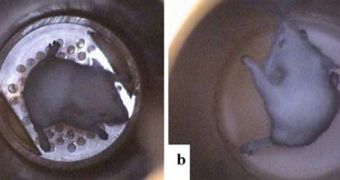Scientists working with the American space agency NASA have recently devised a new machine that allows them to simulate various levels of gravity. Made of high-capacity, super-conducting magnets, the device proved able to maintain a three-week-old mouse in 0-gravity. Because the rodent is very similar to us genetically, the new achievement could have significant implications on research dealing with the effects of no gravity on the human muscle and bone system, and could help researchers devise new ways of counteracting these effects during long journeys, as, for instance, to Mars.
According to the science team behind the accomplishment, the new instrument has an opening 2.6 inches (6.6 cm) wide, large enough for the ten-gram rodent to float around. The mouse was agitated and confused, and appeared to be trying to grab hold of something, once the machine started working. “It actually kicked around and started to spin, and without friction, it could spin faster and faster, and we think that made it even more disoriented,” NASA Jet Propulsion Laboratory (JPL) physicist Yuanming Liu, a member of the research group, shares.
Physicist Da-Ming Zhu, from the University of Missouri in Kansas City, devised a plastic cage that allowed for optimum surveillance of the mouse inside. The top was opened, so as to allow for food and water to be placed inside, as well as for video surveillance, while the bottom had tiny holes in it, which allowed for waste removal. The cage is a very important accomplishment, because it allows for comparative studies between animals subjected to 0-gravity and those living under normal conditions. In order for such a comparison to be successful, the conditions inside the cages need to be the same.
“We're trying to see what kind of physiological impact is due to prolonged microgravity, and also what kind of countermeasures might work against it for astronauts. If we can contribute to the future human exploration of space, that would be very exciting,” Liu explains. He adds that the magnets in themselves do not adversely affect the animals. Previous studies have revealed that rats kept for ten weeks under strong, non-levitating magnetic fields have experienced no side-effects from their exposure.
Details of the new instrument appear in the September 6th issue of the scientific journal Advances in Space Research, LiveScience reports.

 14 DAY TRIAL //
14 DAY TRIAL //